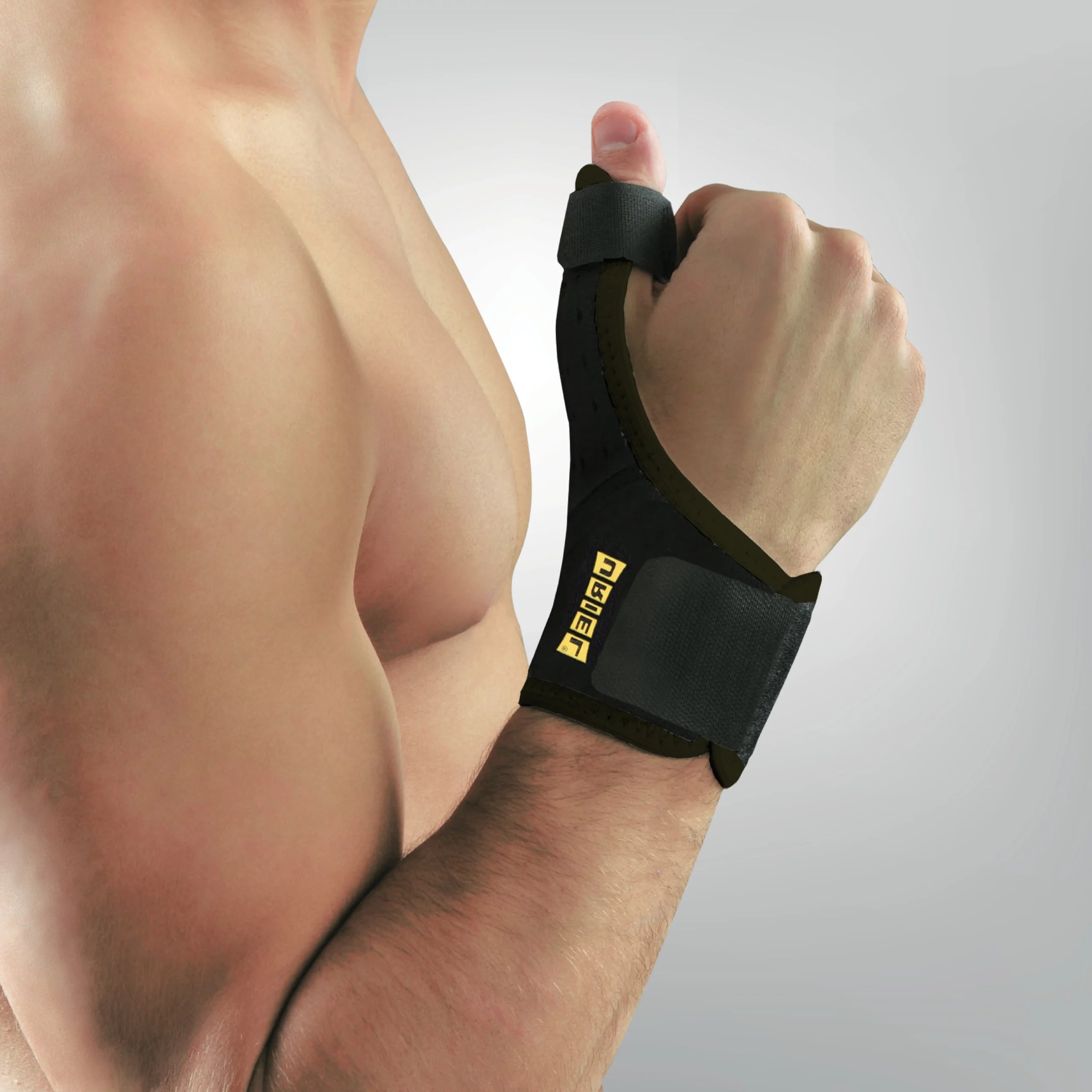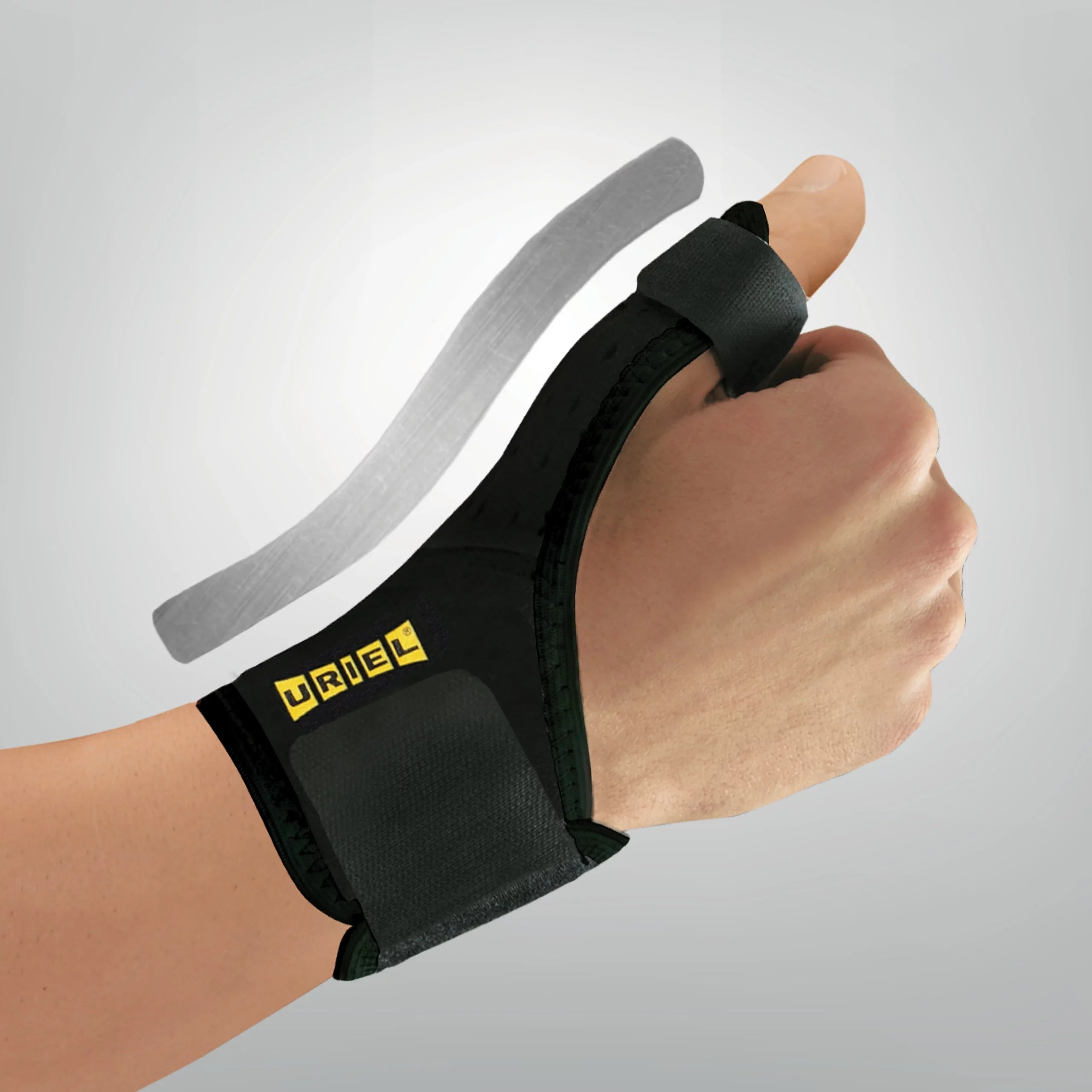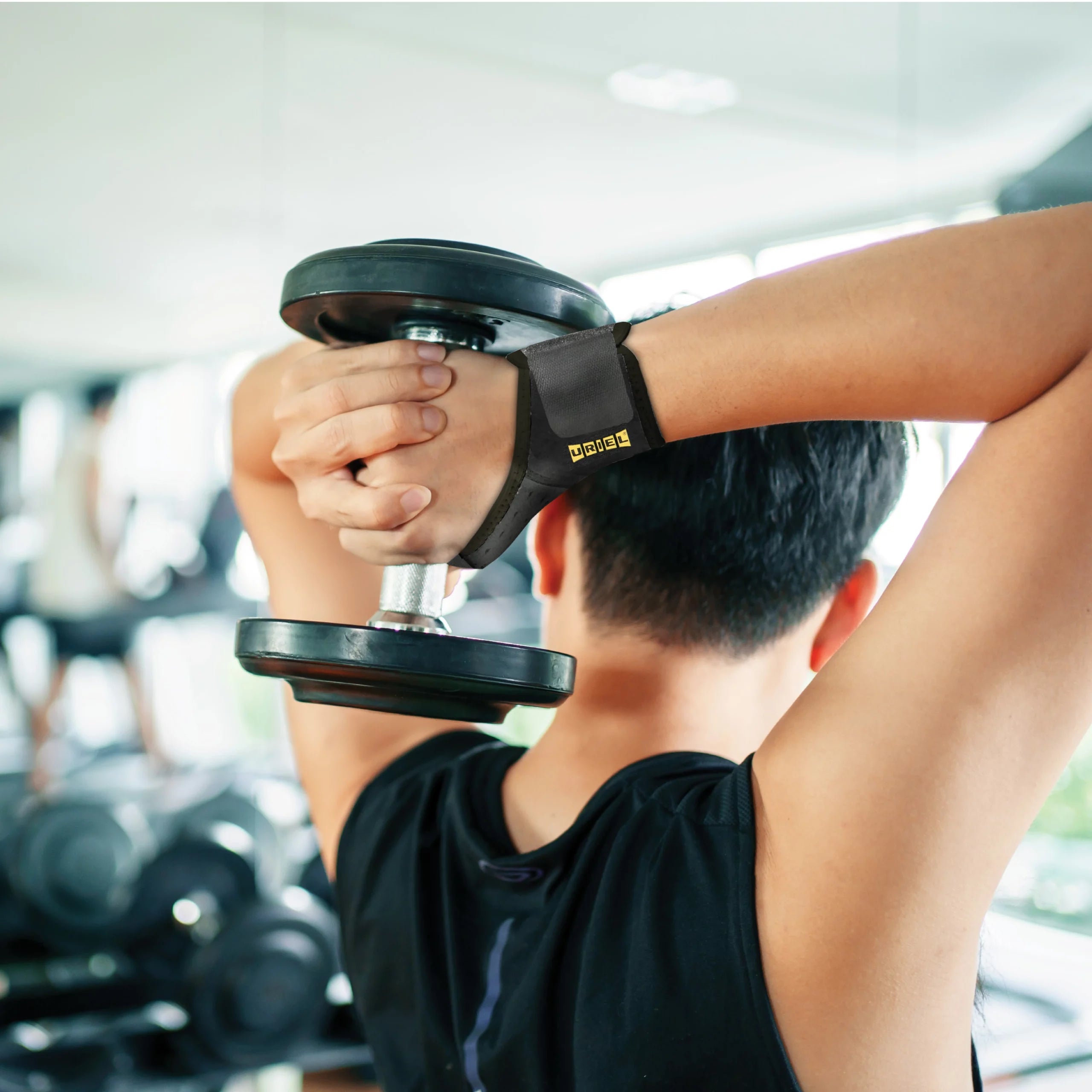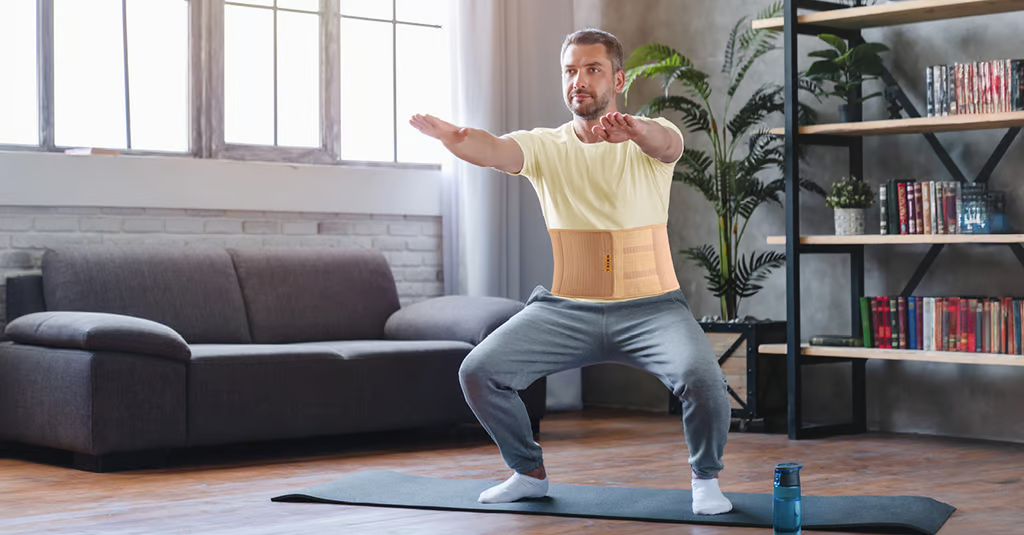


Thumb splint | AC28
Thumb splint combined with an aluminum stabilizer.
The product comes with a metal splint for fixing the thumb, for pain relief and after surgery or cast removal, made of flexible, breathable elastic material. The splint that fixes the thumb reduces the thumb's range of motion. The splint allows the thumb to rest after surgery or injury. The splint provides the thumb area and its circumference with support and local pressure.
Suitable for right and left hand.
Medical indications:
- Thumb sprain or strain
- Thumb sports injuries
- Ulnar collateral ligament strain
- After an injury to the scaphoid bone
- Inflammation of the thumb tendon (De-Quervain's syndrome)
- Rheumatoid Arthritis
- Cartilage erosion (Osteoarthritis)
- Suitable for chronic or acute thumb pain conditions

Dimensions

Extended description
Planning and design:
The function of the brace is to fix and stabilize the thumb in an anatomical position. The brace does this thanks to the lateral aluminum stabilizer threaded into a unique sleeve. This stabilizer can be shaped and adjusted according to the shape of each user's hand. The brace has a minimalist design to allow full movement of the other joints in the palm of the hand. The product is designed with a low profile, is easy to put on and take off, is airy and allows for comfortable wearing throughout the day.
After a few minutes of use, you won't feel it on you.
Pain reduction:
Thumb pain can significantly impact daily functioning. A thumb splint reduces range of motion, thereby reducing strain and pain in the thumb joints (CMC, MCP).
Daily activities where a thumb splint can reduce pain:
The brace is designed to be worn during activity. The brace assists in activities that require thumb activation such as firm handshakes, writing, driving, skiing, housework and gardening, closing/opening a cork, turning a key in a door, walking with Nordic poles and more, thus enabling daily activities to be performed with confidence and comfort.
Rehabilitation and recovery:
As pain improves, the aluminum stabilizer can be removed and the brace can be used without it. As pain improves, more activities can be performed with less pain. Improved thumb function allows for customized exercises to complete the healing process and eliminate pain completely.
User manual
- Choose the product that best suits you, depending on your situation.
- Choose the appropriate size according to the size chart on the packaging.
- Place the product on your thumb and adjust the aluminum strip to the natural shape of your thumb.
- Tighten the Velcro closure to achieve full stabilization, but not too tight so that the strap does not stop blood flow.
- Use the splint as needed.
- If the pain has gone, stop using the brace.
- It is recommended to perform exercises to strengthen muscles and improve range of motion, according to the instructions of the medical professional managing the case.
- Clean the product occasionally depending on the degree of use according to the instructions on the label.
Our expert advice
- Try to understand the initial cause of the thumb pain, and look for any ongoing activities or conditions that perpetuate the pain. If you find any, work to eliminate these factors.
- If you work in an office, make sure your equipment is ergonomic and allows you to work comfortably and mindfully.
- In cases of sports injuries such as sprained fingers and strained tendons, it is recommended to use ice on the area in the first few days after the injury. It is common to use ice for 15-20 minutes, once every 3 hours.
- For effective cooling, it is recommended to use a cooling pad.
- If the pain returns after training or playing, it is recommended to use ice again, even if the original injury occurred a long time ago.
- If the pain is bothersome before an important game or a specific event where the thumb needs to be at its best, you can apply an alternating heat-cold technique. Prepare a hot and cold pad in front of you, place the hot pad on the thumb for 90 seconds. When finished, remove the hot pad and immediately place the cold pad on the thumb for 90 seconds. Continue alternating the pads on the thumb for 90 seconds each time, for 12 minutes.
- Ointments, patches, or gels containing pain-relieving or anti-inflammatory ingredients can provide temporary relief when applied directly to the thumb. Follow the instructions on the product and consult a pharmacist if necessary.
- Spend time doing the exercises that are right for you . It is normal to feel some pain while doing the exercises. If the pain subsides after about 10 minutes of continuous practice, this is a sign that the exercises are relevant and will help over time. The exercises have a cumulative effect after daily practice for a period of several weeks.
- Exercises should be started at a low intensity and increased according to how you feel.
Recommended exercises:
- A. Improving range of motion : Straighten your thumb and with your other hand, stretch your thumb backward for 45 seconds. Do this in other directions of your thumb.
- B. Improving mobility : Gently move your thumb in circles. Use your other hand to achieve the full range of motion possible.
- C. Self-massage: Perform self-massage of the thumb and palm muscles.
If there is no improvement in your condition, consult a doctor or physical therapist about additional treatment options.

Planning and design:
The function of the brace is to fix and stabilize the thumb in an anatomical position. The brace does this thanks to the lateral aluminum stabilizer threaded into a unique sleeve. This stabilizer can be shaped and adjusted according to the shape of each user's hand. The brace has a minimalist design to allow full movement of the other joints in the palm of the hand. The product is designed with a low profile, is easy to put on and take off, is airy and allows for comfortable wearing throughout the day.
After a few minutes of use, you won't feel it on you.
Pain reduction:
Thumb pain can significantly impact daily functioning. A thumb splint reduces range of motion, thereby reducing strain and pain in the thumb joints (CMC, MCP).
Daily activities where a thumb splint can reduce pain:
The brace is designed to be worn during activity. The brace assists in activities that require thumb activation such as firm handshakes, writing, driving, skiing, housework and gardening, closing/opening a cork, turning a key in a door, walking with Nordic poles and more, thus enabling daily activities to be performed with confidence and comfort.
Rehabilitation and recovery:
As pain improves, the aluminum stabilizer can be removed and the brace can be used without it. As pain improves, more activities can be performed with less pain. Improved thumb function allows for customized exercises to complete the healing process and eliminate pain completely.
- Choose the product that best suits you, depending on your situation.
- Choose the appropriate size according to the size chart on the packaging.
- Place the product on your thumb and adjust the aluminum strip to the natural shape of your thumb.
- Tighten the Velcro closure to achieve full stabilization, but not too tight so that the strap does not stop blood flow.
- Use the splint as needed.
- If the pain has gone, stop using the brace.
- It is recommended to perform exercises to strengthen muscles and improve range of motion, according to the instructions of the medical professional managing the case.
- Clean the product occasionally depending on the degree of use according to the instructions on the label.
- Try to understand the initial cause of the thumb pain, and look for any ongoing activities or conditions that perpetuate the pain. If you find any, work to eliminate these factors.
- If you work in an office, make sure your equipment is ergonomic and allows you to work comfortably and mindfully.
- In cases of sports injuries such as sprained fingers and strained tendons, it is recommended to use ice on the area in the first few days after the injury. It is common to use ice for 15-20 minutes, once every 3 hours.
- For effective cooling, it is recommended to use a cooling pad.
- If the pain returns after training or playing, it is recommended to use ice again, even if the original injury occurred a long time ago.
- If the pain is bothersome before an important game or a specific event where the thumb needs to be at its best, you can apply an alternating heat-cold technique. Prepare a hot and cold pad in front of you, place the hot pad on the thumb for 90 seconds. When finished, remove the hot pad and immediately place the cold pad on the thumb for 90 seconds. Continue alternating the pads on the thumb for 90 seconds each time, for 12 minutes.
- Ointments, patches, or gels containing pain-relieving or anti-inflammatory ingredients can provide temporary relief when applied directly to the thumb. Follow the instructions on the product and consult a pharmacist if necessary.
- Spend time doing the exercises that are right for you . It is normal to feel some pain while doing the exercises. If the pain subsides after about 10 minutes of continuous practice, this is a sign that the exercises are relevant and will help over time. The exercises have a cumulative effect after daily practice for a period of several weeks.
- Exercises should be started at a low intensity and increased according to how you feel.
Recommended exercises:
- A. Improving range of motion : Straighten your thumb and with your other hand, stretch your thumb backward for 45 seconds. Do this in other directions of your thumb.
- B. Improving mobility : Gently move your thumb in circles. Use your other hand to achieve the full range of motion possible.
- C. Self-massage: Perform self-massage of the thumb and palm muscles.
If there is no improvement in your condition, consult a doctor or physical therapist about additional treatment options.
Blog

Treating Lower Back Pain: 6 Tips to Improve Quality of Life
Suffering from lower back pain? You are definitely not alone. There are many ways to deal with one of the most common pains in the world, here are some of them. It's time to relieve the pain.

The Secret to a Healthy Back: The Complete Guide to Improving Posture and Alleviating Back Pain
Is back health important to you? Get the 'Secret of a Healthy Back' guide containing information, tips and useful advice for relieving back pain. By Oriya Moran, Chief Physiotherapist Download t...

Kinesio tape or professional elastic bandage?
Suffering from sports injuries, bruises or simply pain caused by medical problems? Get to know the variety of dressing products that will support you. When should we use kinesiology tape and why d...
